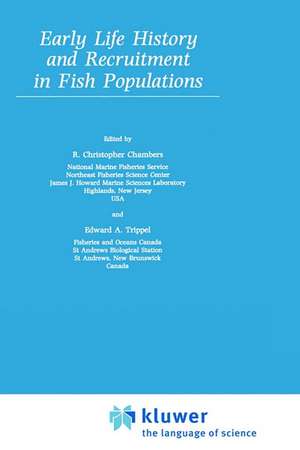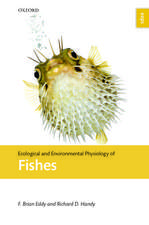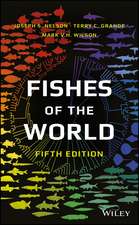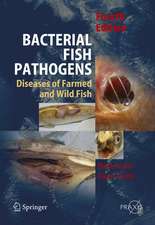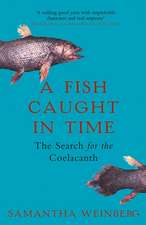Early Life History and Recruitment in Fish Populations: Fish & Fisheries Series, cartea 21
Editat de R.C. Chambers, Edward A. Trippelen Limba Engleză Hardback – 31 iul 1997
This important volume brings together contributions from many of the world's leading researchers from the field of fish ecology. The book focuses on three major themes of pressing importance in the analysis of the role that the early life history of fishes plays in the number and quality of recruits: the selective processes at play in their early life history; the contributions of early life history to the understanding of recruitment.
| Toate formatele și edițiile | Preț | Express |
|---|---|---|
| Paperback (1) | 1831.60 lei 6-8 săpt. | |
| SPRINGER NETHERLANDS – 20 sep 2011 | 1831.60 lei 6-8 săpt. | |
| Hardback (1) | 1837.88 lei 6-8 săpt. | |
| SPRINGER NETHERLANDS – 31 iul 1997 | 1837.88 lei 6-8 săpt. |
Din seria Fish & Fisheries Series
- 18%
 Preț: 1116.09 lei
Preț: 1116.09 lei - 18%
 Preț: 978.12 lei
Preț: 978.12 lei - 18%
 Preț: 1242.66 lei
Preț: 1242.66 lei - 18%
 Preț: 1223.74 lei
Preț: 1223.74 lei - 18%
 Preț: 1224.85 lei
Preț: 1224.85 lei - 18%
 Preț: 942.76 lei
Preț: 942.76 lei - 18%
 Preț: 1233.06 lei
Preț: 1233.06 lei - 15%
 Preț: 647.40 lei
Preț: 647.40 lei - 18%
 Preț: 2490.41 lei
Preț: 2490.41 lei - 18%
 Preț: 1239.19 lei
Preț: 1239.19 lei - 24%
 Preț: 1301.42 lei
Preț: 1301.42 lei - 18%
 Preț: 2099.91 lei
Preț: 2099.91 lei - 15%
 Preț: 650.19 lei
Preț: 650.19 lei - 18%
 Preț: 1227.21 lei
Preț: 1227.21 lei - 18%
 Preț: 1230.84 lei
Preț: 1230.84 lei - 18%
 Preț: 947.35 lei
Preț: 947.35 lei - 18%
 Preț: 961.86 lei
Preț: 961.86 lei - 18%
 Preț: 1234.00 lei
Preț: 1234.00 lei - 18%
 Preț: 1226.11 lei
Preț: 1226.11 lei - 18%
 Preț: 1224.99 lei
Preț: 1224.99 lei - 18%
 Preț: 1234.00 lei
Preț: 1234.00 lei - 18%
 Preț: 1234.62 lei
Preț: 1234.62 lei - 15%
 Preț: 716.15 lei
Preț: 716.15 lei - 18%
 Preț: 1236.19 lei
Preț: 1236.19 lei - 18%
 Preț: 975.73 lei
Preț: 975.73 lei - 18%
 Preț: 1229.91 lei
Preț: 1229.91 lei - 18%
 Preț: 2325.45 lei
Preț: 2325.45 lei - 18%
 Preț: 995.34 lei
Preț: 995.34 lei - 18%
 Preț: 1233.20 lei
Preț: 1233.20 lei - 18%
 Preț: 1230.66 lei
Preț: 1230.66 lei
Preț: 1837.88 lei
Preț vechi: 2241.32 lei
-18% Nou
Puncte Express: 2757
Preț estimativ în valută:
351.72€ • 381.92$ • 295.44£
351.72€ • 381.92$ • 295.44£
Carte tipărită la comandă
Livrare economică 22 aprilie-06 mai
Preluare comenzi: 021 569.72.76
Specificații
ISBN-13: 9780412641909
ISBN-10: 0412641909
Pagini: 596
Ilustrații: XXXII, 596 p.
Dimensiuni: 156 x 234 x 35 mm
Greutate: 1.05 kg
Ediția:1997
Editura: SPRINGER NETHERLANDS
Colecția Springer
Seria Fish & Fisheries Series
Locul publicării:Dordrecht, Netherlands
ISBN-10: 0412641909
Pagini: 596
Ilustrații: XXXII, 596 p.
Dimensiuni: 156 x 234 x 35 mm
Greutate: 1.05 kg
Ediția:1997
Editura: SPRINGER NETHERLANDS
Colecția Springer
Seria Fish & Fisheries Series
Locul publicării:Dordrecht, Netherlands
Public țintă
ResearchCuprins
1 Prologue. Recruitment in fish populations: the paradigm shift generated by ICES Committee A.- 1.1 Introduction.- 1.2 The naming of ICES Committee A.- 1.3 The scope of work undertaken by Committee A.- 1.4 The groundfish egg and larval studies of Committee A.- 1.5 Hjort’s new paradigm.- 1.6 Summary of importance of early life history studies on the paradigm shift.- 1.7 Influence of Hjort on recruitment studies between 1914 and 1930.- 1.8 The Canadian Fisheries Expedition.- 1.9 Conclusions.- Acknowledgements.- References.- One Parent-Progeny Relationships.- 2 Effects of adult age and size structure on reproductive output in marine fishes.- 3 Environmental influences on egg and propagule sizes in marine fishes.- 4 Regulation of energy acquisition and allocation to respiration, growth and reproduction: simulation model and example using rainbow trout.- 5 Life history responses to environmental variability in early life.- Two Selective Processes in the Early Life History.- 6 Patterns and consequences of selective processes in teleost early life histories.- 7 The use of field studies to investigate selective processes in fish early life history.- 8 Ontogeny, growth and the recruitment process.- 9 Ontogeny of cannibalism in larval and juvenile fishes with special emphasis on Atlantic cod.- 10 Size-selective predation on juvenile North Sea flatfish and possible implications for recruitment.- 11 Natural selection and the evolution of growth rate in the early life history: what are the trade-offs?.- 12 Predation on juvenile fishes: dynamic interactions between size-structured predators and prey.- 13 Size-based foraging success and vulnerability to predation: selection of survivors in individual-based models of larval fish populations.- Three Contribution of Early Life HistoryStudies to our Understanding of Recruitment.- 14 Compensatory responses to decreased young-of-the-year survival: an individual-based modelling analysis of winter flounder.- 15 Relationships between early life history traits and recruitment among coral reef fishes.- 16 Recruitment variation in fish populations assessed using meta-analysis.- 17 Interannual variability in stage-specific survival rates and the causes of recruitment variation.- 18 The utility of early life history studies and the challenges of recruitment prediction.- Four Conclusions.- 19 Early life history and recruitment: legacy and challenges.- 20 Epilogue. The Three Cavaliers: a discussion from the golden age of Norwegian marine research.- Author index.- Location index.- Species index.
